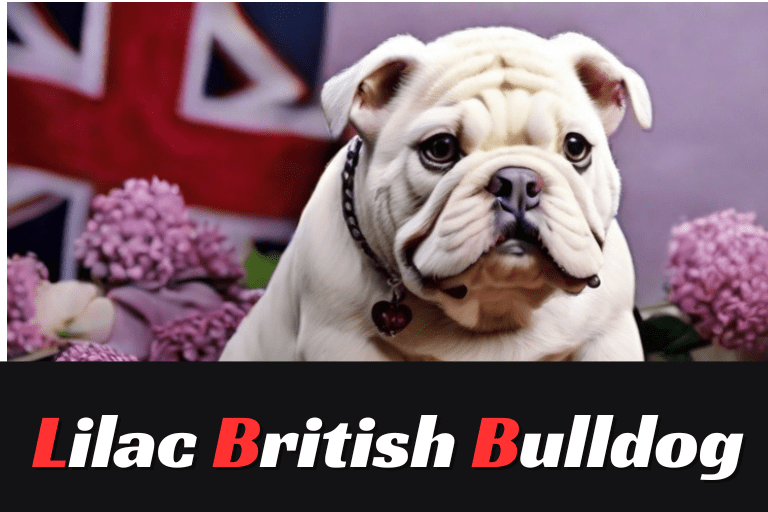Lilac British Bulldog
Let’s explore the topic of Lilac British Bulldog. The British Bulldog is an iconic and beloved breed known for its distinctive appearance and loyal temperament.
Among the various color variations of the British Bulldog, the lilac coat stands out as one of the most rare and sought-after.
In this comprehensive guide, we’ll delve into the world of the lilac British Bulldog, exploring its unique characteristics, history, care requirements, and more.
1. Introduction to the Lilac British Bulldog
The lilac British Bulldog is a striking variation of the classic Bulldog breed, characterized by its soft, lavender-toned coat and distinctive facial wrinkles.

While Bulldogs come in a variety of colors, including brindle, fawn, and white, the lilac coloration is relatively rare and highly coveted among enthusiasts and breeders.
2. Understanding the Genetics of the Lilac Coat
The lilac coloration in British Bulldogs is the result of specific genetic factors. It is a diluted version of the chocolate gene, which affects the pigmentation of the dog’s coat.
Bulldogs inherit their coat color from their parents, with both the dam and sire contributing genes that determine the color of their offspring’s coat.
3. Characteristics of the Lilac British Bulldog
In addition to their unique coat color, lilac British Bulldogs share many of the same characteristics as their standard-colored counterparts.
They are known for their muscular build, broad head, and distinctive pushed-in nose. Despite their intimidating appearance, Bulldogs are gentle, affectionate companions that form strong bonds with their families.
4. History of the British Bulldog Breed

The British Bulldog has a rich and storied history that dates back centuries. Originally bred for bull-baiting, a brutal sport popular in medieval England, Bulldogs were later bred for their tenacity, strength, and courage.
Over time, they transitioned from working dogs to beloved companions, gaining popularity as family pets and symbols of British resilience and determination.
5. Care and Maintenance of Lilac British Bulldogs
Like all Bulldogs, lilac British Bulldogs require proper care and maintenance to ensure their health and well-being. This includes regular exercise to prevent obesity, as Bulldogs are prone to weight gain, as well as routine grooming to keep their coat clean and free of mats.
Additionally, Bulldogs are brachycephalic breeds, meaning they have shortened snouts, which can lead to breathing difficulties, especially in hot weather. It’s essential to keep them cool and provide plenty of shade and water during hot summer months.
6. Training and Socialization
Despite their stubborn streak, Bulldogs are intelligent and trainable dogs. Early socialization and positive reinforcement training are crucial for shaping their behavior and preventing behavioral issues.
With patience, consistency, and plenty of rewards, lilac British Bulldogs can excel in obedience training and become well-mannered companions.
7. Health Considerations for Lilac British Bulldogs

While Bulldogs are generally healthy and robust dogs, they are prone to certain health issues due to their unique anatomy. These may include brachycephalic airway syndrome, hip dysplasia, and skin fold dermatitis.
Regular veterinary check-ups, a balanced diet, and proper preventive care can help mitigate the risk of these health concerns and ensure a long and healthy life for your lilac British Bulldog.
8. Finding a Reputable Breeder
If you’re considering adding a lilac British Bulldog to your family, it’s essential to find a reputable breeder who prioritizes health, temperament, and responsible breeding practices.
Research breeders carefully, ask for references, and visit their facilities to ensure they provide a loving and nurturing environment for their dogs.
9. Cost of Owning a Lilac British Bulldog
Lilac British Bulldogs are considered a rare and exotic breed, and their price reflects their status. Expect to pay a premium for a well-bred lilac Bulldog puppy from a reputable breeder. Additionally, factor in ongoing expenses such as food, grooming, veterinary care, and training.
10. Conclusion

The lilac British Bulldog is a rare and stunning breed that captivates hearts with its unique appearance and gentle demeanor.
Whether you’re drawn to their striking coat color or charmed by their affectionate nature, owning a lilac Bulldog is a rewarding experience.
By understanding their care requirements, health considerations, and finding a reputable breeder, you can provide your lilac British Bulldog with a happy, healthy, and fulfilling life as a cherished member of your family.
FAQs
Here are some FAQs related to Lilac British Bulldog.
- What is a lilac British Bulldog?
- A lilac British Bulldog is a variation of the classic Bulldog breed characterized by its rare and distinctive lilac-colored coat. It is a diluted version of the chocolate gene, resulting in a soft lavender-toned coat that sets it apart from other Bulldog colors.
- Are lilac British Bulldogs rare?
- Yes, lilac British Bulldogs are considered rare and highly sought after by enthusiasts and breeders. Their unique coat color makes them stand out from the standard color variations of the breed, such as brindle, fawn, and white.
- What are the genetics behind the lilac coat color?
- The lilac coat color in British Bulldogs is the result of specific genetic factors, particularly the dilution of the chocolate gene. Bulldogs inherit their coat color from their parents, with both the dam and sire contributing genes that determine the color of their offspring’s coat.
- How do I care for a lilac British Bulldog?
- Caring for a lilac British Bulldog is similar to caring for any other Bulldog breed. This includes regular exercise to prevent obesity, routine grooming to keep their coat clean and free of mats, and providing plenty of shade and water to prevent overheating, especially in hot weather.
- Are lilac British Bulldogs prone to health issues?
- Like all Bulldogs, lilac British Bulldogs may be prone to certain health issues due to their unique anatomy. These may include brachycephalic airway syndrome, hip dysplasia, and skin fold dermatitis. Regular veterinary check-ups, a balanced diet, and proper preventive care can help mitigate these risks.
- How can I find a reputable breeder for a lilac British Bulldog?
- When searching for a lilac British Bulldog puppy, it’s essential to find a reputable breeder who prioritizes health, temperament, and responsible breeding practices. Research breeders carefully, ask for references, and visit their facilities to ensure they provide a loving and nurturing environment for their dogs.
- What is the cost of owning a lilac British Bulldog?
- Lilac British Bulldogs are considered rare and exotic breeds, and their price reflects their status. Expect to pay a premium for a well-bred lilac Bulldog puppy from a reputable breeder. Additionally, factor in ongoing expenses such as food, grooming, veterinary care, and training.
- Are lilac British Bulldogs good family pets?
- Yes, lilac British Bulldogs make excellent family pets. They are known for their gentle and affectionate nature, loyalty to their families, and ability to get along well with children and other pets when properly socialized and trained.
- Do lilac British Bulldogs require special care or attention?
- While lilac British Bulldogs do not require any special care compared to other Bulldogs, it’s essential to be mindful of their unique health considerations, such as brachycephalic airway syndrome. Provide them with a comfortable environment, regular exercise, and routine veterinary care to ensure their health and well-being.
- Can I show a lilac British Bulldog in dog competitions or exhibitions?
- Yes, lilac British Bulldogs can participate in dog shows, competitions, and exhibitions, provided they meet the breed standards set by the respective kennel clubs or organizations. However, it’s essential to research the specific requirements and guidelines for exhibiting Bulldogs in your region.
Related Posts:
- Let’s understand: Aggression in French Bulldogs 5 Reasons
- Let’s understand: Full Grown French Bulldog with Floppy Ears in 2024
- Let’s understand: Why Are Pugs So Ugly? 5 Reasons
- Let’s understand: Top 10 Dog Breeds with an Underbite in 2024
- Let’s understand Is Pura Safe for Cats?

